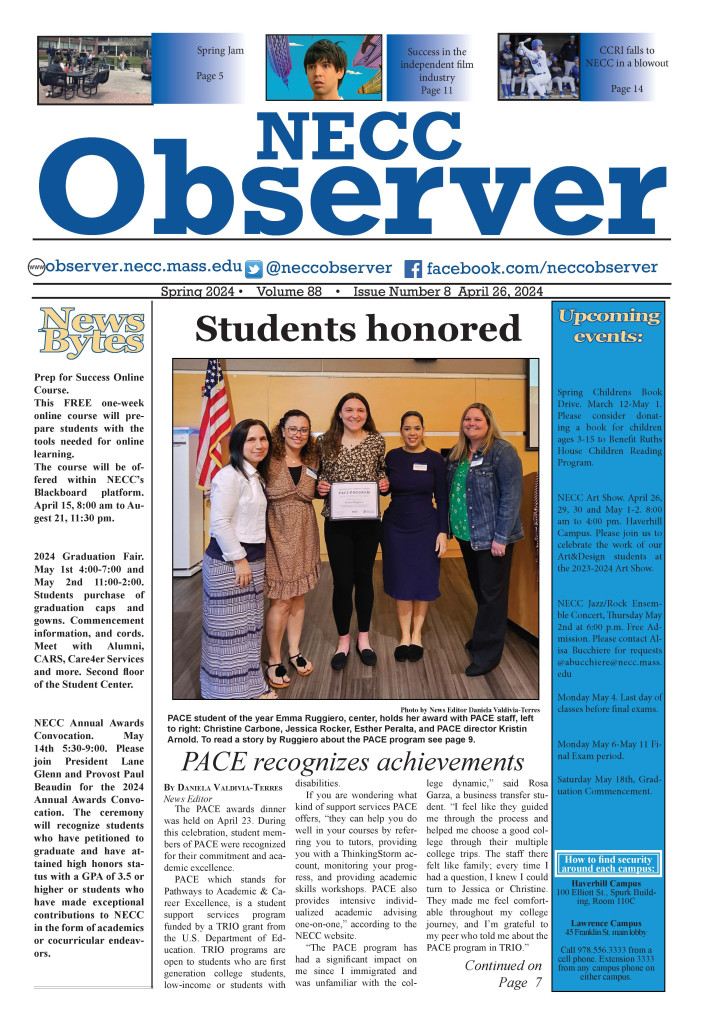
Plant Paint Cross Pollinate recently touched down on the Lawrence campus.
The positive environmental art project landed at the new art gallery in the Fournier building on Amesbury Street on Feb. 19.
Students, faculty and members of the public learned about the importance of Monarch butterflies as pollinators. They planted native seeds which they took home to start their own eco-garden to attract pollinators. Participants also painted native flowers on wooden canvas with the shape of native butterflies which will be part of an itinerant art expo throughout the Merrimack Valley.
The event was a fully enriched hands-on learning experience.
Jenn Houle, the creative mind and leader of this project, is an adjunct professor in the Art & Design Department. She introduced the audience to a range of pollinators like honeybees, wasps, beetles, moths and native butterflies.
These insects play a critical role in our food production system.
According to the USDA, three-fourths of the world’s flowering plants and about 35% of the world’s food crops depend on animal pollinators to reproduce.
That’s one out of every three bites of food we eat exists because of a pollinator.
Fun fact: Some birds and bats are also pollinators. Bats also help to keep crops safe by consuming nightly mosquitos or forest pests saving billions of dollars in pest control.
Houle also educated us about native species to plant in our garden to create a habitat for pollinators.
With the promise of having a colorful garden when spring sprang, each participant put sole in small containers and chose among a flower plant list their favorite native seed to grow.
Even people like me that are far from being a green thumb, indeed even a cactus did not survive under my will, were cheerfully participating.
Taking pictures of the chosen plant description to learn about their care, carefully adding soil before and sand after planting their seeds and writing the scientific / common name of the plant on small sticks, were part of this amusing activity.
The event landed on the art main project to create awareness about the importance of these hard-working insects. The audience was encouraged to paint large-scale cut out butterfly signs. These anatomical shapes belong to the five families of butterflies found in Massachusetts: swallowtails, whites and sulphur’s, gossamer-wings, brush footed butterflies and skippers.
“I have no experience in drawing or painting, I am afraid to ruin it!” said one participant. However, Houle offered handouts with drawing and painting techniques and patiently directed each participant to draft with chalks and use acrylic paint fearlessly directly on the signs.
But why butterflies’ signs instead of bees or another pollinator? Houle explained, “I chose the butterfly because it is a powerful symbol of transformation, and nature’s ability to metamorphose into something else. Butterflies are beautiful, their life cycle is almost magical. They are a ‘charismatic species’ which are animals that scientists realize easily capture the public’s love, imagination, care or attention. Charismatic species are often beautiful or visually striking and help ease the entry and connection to environmental conservation issues. I want to support all pollinators, and the seeds we plant will help do so!”
The project’s activities have been presented since January in different locations such the public libraries of Amesbury and Haverhill.
The Lawrence campus art gallery was the last call. This project will generate 20 colossal painted butterfly signs which will be part of Butterfly Mural Migration, which will tour from May – Oct. 2023 throughout Amesbury, Groveland, Haverhill, Merrimac, Newbury and West Newbury on public conservation land, at public libraries, and around local schools.
The audience left with new knowledge about pollinators, delighted with their artistic contribution for the murals, and ultimately, inspired to collaborate in creating habitats for pollinators and support our ecosystem from their own backyards or planters.
More about the art project leader: Jenn Houle received her bachelor’s degree in art from Massachusetts College of Art and Design in 2007.
She later received her master’s degree in art from Cornell University in 2015.
She teaches 2D Foundations and Drawing at NECC. She also teaches at Fitchburg State University. Contact her at jhoule@necc.mass.edu or visit www.jennhoule.com
This program is supported in part by grants from the Amesbury, Groveland, Haverhill, Merrimac, Newbury and West Newbury Cultural Councils, local agencies which are supported by the Mass Cultural Council, a state agency. Also sponsored by Mel’s Record Shop, Water Street Realty Trust and BareWolf Brewing. Soil donation from Coast of Maine & Aubuchon Hardware Haverhill.

